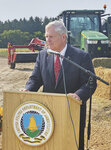

ARKANSAW, Wis. – Agriculture Secretary Tom Vilsack announced details of the U.S. Department of Agriculture’s Partnerships for Climate-Smart Commodities program Sept. 14. The program is investing up to $2.8 billion in 70 selected projects under the first pool of funding.
[[In-content Ad]]
“It’s a tremendous opportunity for American agriculture to not only improve the bottom line but to improve conditions on the planet,” Vilsack said. “(We want to be) in a position where internationally we can say to the rest of the world, ‘Follow us. We’re leading.’”
Vilsack was joined by representatives from Organic Valley, Edge Dairy Farmer Cooperative and The DeLong Co. Inc., who are participating in the program, at a press conference Sept. 15 at the Anibas family farm near Arkansaw.
The purpose of the program is to fund pilot projects that will create market opportunities for American commodities produced using climate-smart production practices. The program comes in response to the challenges facing producers today and a growing demand for sustainably produced products from the export market.
Recipients of the program were selected from more than 1,000 applications from food companies. Originally, $1 billion was allocated from the Commodity Credit Corporation to the project. After receiving so many applications, however, additional funding was set aside for the program.
“Basically, we have a $3.5 billion initiative,” Vilsack said. “What we are announcing is 70 projects in the larger grant pool, allocating $2.8 billion to those 70 projects.”
Producers in all 50 states will participate in the program including an array of commodities. The USDA expects more than 50,000 farmers to participate in the effort and up to 25 million acres of land across the U.S. to be impacted with climate-smart practices. Vilsack said he expects 100 new market opportunities to become available. It is also anticipated the program will bring the agriculture sector’s carbon footprint closer to neutral.
“We are hopeful that by the time it’s all said and done, roughly 50 million metric tons of greenhouse gas, or CO2 equivalent, is either prevented, eliminated or stored,” Vilsack said.
The program is voluntary, provides incentives for participation without penalizing early adopters, educates the markets to get a higher value for products produced and also encourages partnerships.
Universities, environmental groups, farm groups, processors, retailers and energy companies are just some of the groups forming partnerships in the program. The partnerships are encouraged so data can be accurately collected and analyzed, thus ensuring appropriate value to the outcomes.
Nicole Rakobitsch, sustainability manager at Organic Valley, said the funding will take the company’s carbon insetting program from a one-year pilot program to a multi-year program. Within five years, she anticipates there will be more trees planted, solar energy systems on farms, increased use of diverse cover crops, increased intensity of grazing and use of feed supplements to reduce entire emissions on dairy farms.
Tim Trotter, CEO of Edge Dairy Farmer Cooperative, said the funding will allow farmers to be innovative with their on-farm practices, which should allow the next generation to carry on within the dairy industry.
Matthew Woods, of The DeLong Co., said the funding will be used to offer per acre direct incentives for farmers who use climate-smart practices on those acres.
“It’s going to cover things like cover crops, nutrient management programs, no till and windbreak establishments,” Woods said. “We are going to be recording on-farm data from those acres that they enroll.”
Vilsack said when he came back to the department, one of the first things that landed on his desk was a report that indicated 89.6% of farms in the country do not generate the majority income for the family on the farm.
“This means that those farms, somebody’s working off the farm,” Vilsack said. “We can’t say that we’ve got a completely successful model if only 10% of the folks in agriculture are able to make a living off of what they do and what they love to do. So, our task at USDA is to figure out more and better markets.”
Comments
No comments on this item Please log in to comment by clicking here